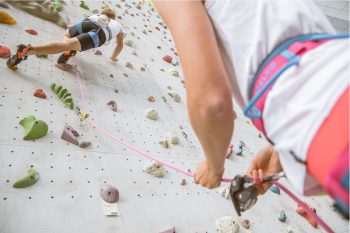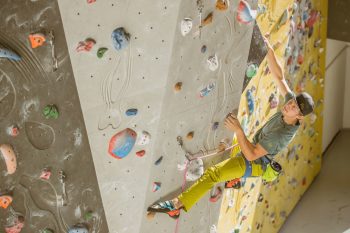1. Take a course
Safety is the most important thing when climbing – after all, you hang several meters above the ground each time and are mainly held by your partner’s counterweight. In a climbing course, you will learn which knots you have to master and what you have to pay attention to when belaying, leading, and lowering off.
Indoor climbing gyms offer great courses that teach the basics of staying safe.
Important: Once you have completed your course, you should get on it immediately – and not just drive to the Algarve for four weeks of surf and sun. After a month, you will probably not remember much about double boulin knots or how to use your Grigri. Thus, Do a course and go climbing!
2. Find your perfect partner
In most cases, climbing is only possible as a team of two. Awesome if you already have a partner who knows how to belay or has taken a course with you. If not, you can find like-minded people in a climbing course, in forums, or on your gym’s (virtual) notice board. When choosing your partner, ensure your body weight is not too far apart. The DAV (German Alpine Club) advises keeping the difference below 10 kilograms. If this is not possible, the lighter partner can use a sandbag (usually supplied at the gym) or get hold of an Ohm. The small device is clipped into the first intermediate hanger when lead climbing increases friction. This allows for weight differences of up to 40 kilograms to be safely handled.
3. Choose the right gear
Luckily, the gear for climbing down at the wall does not cost the world:
- Belay device: The DAV (German Alpine Club) recommends using semi-automatic devices, such as the Grigri by Petzl, which locks off automatically and thus increases the climber’s safety in the event of a fall or when being lowered off. For any belay device, you still need a carabiner. The safest are Trilock gates with anti-twist protection. Please note that not every carabiner can be matched with any belay device. You can get information about this from your trusted retailer.
- Climbing harness: here, it does not have to be the ultra-performance harness. If you are a beginner, a cheaper model will do fine. These are often available for as little as 60 Euros. Ensure that the harness fits you well, i.e., that it sits right on your hips and that the leg loops are not too wide.
- Chalk bags, incl. chalk: In the Chalk bag, you keep magnesia, the stuff that keeps your hands dry while climbing. Chalk bags work best when you tie them around your waist with an extra cord. You can also attach the chalk bag to the back of the climbing harness, but then the magnesia bags often hang a bit too low.
- Climbing shoes: They do not have to be the most expensive. What matters is that they are tight and that you are not in agony when you wear them.
- Climbing rope: Climbing ropes exist in a dime a dozen. For the gym, you need a 50-meter rope with a diameter of about 10 millimeters. Special indoor climbing ropes also have a slightly thicker sheath and wear out more slowly.
- Optional: Edelrid Ohm: Edelrid’s Ohm is a unique device. It is hung in the rope and attached to the first protection point. It increases the friction of the rope and thus enables two climbers of different weights to climb together without any danger.
- Optional: Belay glasses: Are you tired of constantly looking upwards to see your partner? Do you maybe even get problems with your neck? Then belay glasses are right for you: They are fitted with prisms and allow you to follow your partner’s every move without straining your neck.
- Climbing clothing: Don’t worry; you don’t have to get into full climbing apparel immediately; a pair of comfortable joggers and a T-shirt are sufficient for the beginning. You must have enough freedom of movement and not sweat. Unfortunately, you can’t climb with your gear forever. All safety-relevant textile materials are subject to aging, wear, and tear. If you climb keenly, you may have to change your harness and rope yearly. Your retailer or the manufacturer will tell you when to replace your gear. Tip: Although the shoes are not safety-relevant, their rubber does wear out. Don’t forget, you can have them re-soled.
4. Stay focused
You have already climbed your fair share of gym routes, and handling your gear has become second nature to you. Great! Nevertheless, please always stay vigilant: Climbing is dangerous, and even on the 200,000 climbs or belays, you simply can’t afford to make any mistakes.
The most important pointers for belayers:
- Think of the partner check
- Take up the safest position at the base of the climb
- Do not give out too much slack
- Never let go of the breaking rope
- Focus on your partner, even if the noise level is loud within the gym
- Do not let others distract you
For climbers:
- Think of the partner check
- Tie in the proper way
- Do not clip from overstretched positions
- Clip all runners
- Clip the lower-offs in the correct fashion
- Keep climbers beneath and next to you in mind
5. Talk about mistakes
Not every climber is as experienced and attentive as you might be. Some climbers make big mistakes, for example, letting go of the belay rope or giving too much slack. In this case, talk to the climbers; they will (hopefully) thank you. But avoid treating people from above in a derogatory way.
6. Avoid injuries
Climbing is possible until old age – and if you keep at it, you will get better and better. But this only applies if you do not hurt yourself (permanently)! Here are some important tips for staying fit as long as possible:
- Warm-up—this applies, particularly to the fingers, arms, and shoulders! Do some light stretching exercises first, and then go on routes that are easy for you.
- Be careful with dynamic moves and crimps; they put more strain on your body than other climbing moves.
- Do not climb until you have any strength left: Then your muscles can no longer maintain the necessary support, which puts more strain on your cartilage and joints
- Take climbing breaks – especially if you are in pain.
- As a beginner, keep your hands off Hangboards & Co. (see point 9)
- Do compensatory exercises: If you don’t stretch enough and strengthen the antagonists while climbing, you can soon develop problems with your shoulders, fingers, or elbows.
- And most important: Have fun and listen to your body!
7. Focus on your technique
Even though climbing is a natural way of moving, the right technique plays a huge role – much more than mere strength. Some top climbers can hardly manage a pull-up. Why are they still able to perform? Because they use the correct technique and have a lot of experience. Therefore, especially at the beginning, you should take a lot of time to determine the correct body positioning, footwork, and grip technique. Watching good climbers, technical training in the gym, YouTube videos, or books can give you some pointers: basic movement patterns are presented and explained step-by-step.
8. Fight your fear
Fear of falling, fear of heights, fear of being exposed: climbing on a rope offers many opportunities to be afraid. Some climbers can focus on the task unhindered by fear; others find solace in top-roping.
If you want to fight your fear, there are several possibilities:
- Books, online articles, and videos offer great pointers for fighting your fear of climbing
- Practicing falling: “Falling is not so bad” will result from your fall training. Tip: Practice in overhangs, very close to the runner (danger of ground fall), when no other climber is near you, and with an experienced belay partner. How do you proceed? Best bit by bit: first, only a few decimetres above the runner, then you move further up the wall. Important: There are also limits to your fall training! At the latest, when you could clip the next draw, you should stop. And: Ground falls remain a possibility up to 6 draws up! Regular practice will help you to overcome your fear.
9. The best training for beginners? Climb!
It is only natural that after your first success in climbing, you want to get better quickly. In the gym, you will also be offered an array of possibilities: System boards in all colors and shapes, fingerboards, rings, pull-up bars, and dumbbells. So it’s only logical to hang on after the climbing session and do a few pull-ups, right? Wrong! Unlike many other training methods, hang boards allow you to hang your entire weight on ten very weak body parts: your fingers. And you don’t train them as fast as the muscles in your calves or biceps – the joints, cartilage, and tendons take a while to get used to climbing.
The most important training tip is, thus, not to train on a hang board before honing your climbing skills to a certain level. Why? a) Because, as a beginner, you will damage your fingers permanently, and b) Because your weak point is not in your biceps but in your head (climbing technique)! If you feel like training, there are still a few possibilities:
- Stimulate your antagonists (e.g., the chest muscles) in a targeted manner; this prevents postural deformities and injuries
- Core exercises help build up the necessary body tension for overhanging climbing and precise, effective footwork.
- Yoga improves your active and passive mobility and helps you, for example, to step up higher on smaller footholds.
- Otherwise: Climb, climb, climb
10. Come outside, get on some real crag
Climbing was not invented indoors. It stems from outside, from the rocks around the world. And believe it or not, there are even more beautiful movements than in the gym. Rock offers infinite possibilities. You are in nature, and the experience will be even more rewarding. Trust us!

